The flag
The flag of the state of Western Australia is the British blue ensign, consisting of a blue flag with the Union Jack occupying the upper quarter next to the staff, and the state badge situated centrally in the fly.
The black swan has been used as the emblem of Western Australia since the 1830s, although there is no record of any early official confirmation.
The use of the black swan on Western Australia's badge, which appears on the state flag, was officially confirmed by the then Colonial Governor Sir Frederick Aloysius Weld in 1875, although it had been appearing on the blue ensign as the Western Australian flag prior to 1870. Originally facing away from the flagpole, the swan was reversed in 1953.
The colour references are:
- Blue: PANTONE® 281C,
- Yellow: PANTONE® 109C,
- Red: PANTONE® 032C,
- White: PANTONE® White, and
- Black: PANTONE® Black.
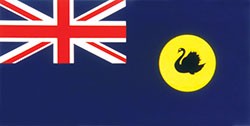
The Coat of Arms
The state Coat of Arms was granted by Queen Elizabeth II by Royal Warrant on 17 March 1969.
Use of the Coat of Arms is protected under the Armorial Bearings Protection Act 1979.
The central part of the Western Australian Coat of Arms is a silver shield showing a black swan floating on a blue base representing water. It is supported by 2 red kangaroos, each holding a boomerang.
The crest on the Coat of Arms is a Royal Crown on a gold and black wreath between 2 kangaroo paw flowers.
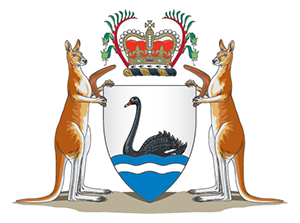
The badge
The state badge is taken from the flag of Western Australia. The colour reference is:
- Yellow: PANTONE® 109C, and
- Black: PANTONE® Black.

The floral emblem
Red and green kangaroo paw
The red and green kangaroo paw was proclaimed the state's floral emblem in November 1960 and was incorporated into the Coat of Arms of Western Australia on 17 March 1969.
Western Australia's floral emblem grows naturally only in Western Australia. The red and green kangaroo paw is striking for its brilliant red and green flowers that appear in spring and summer in fan‑like clusters at the end of red felted stems. The sturdy high stems provide a ready‑made perch for honey‑eaters and wattle‑birds, which are often seen clinging precariously to the stem, drinking nectar from each of the flowers in turn and helping in pollination.
The red and green kangaroo paw is the best known and most famous of all the kangaroo paws. The plants flower from July to November and are usually found in many areas of remnant bushland near Perth and is common in the sandy coastal plains of the south-west of the state, ranging from Shark Bay in the north, to Scott River and Mount Barker in the south.
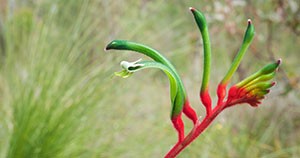
The animal emblem
The numbat
The numbat was declared Western Australia's animal emblem on 25 July 1973. Numbats were once widespread across southern Australia, however the destruction of their habitat through clearing and the arrival of introduced predators such as foxes and cats, have led to their remaining natural population becoming restricted to small pockets in the south-west of Western Australia.
Numbats, also known as the banded anteater, dine among fallen tree trunks and hollow logs on their favourite food, termites. Numbats use their sharp claws to expose the termites and eat them with long, whip-like tongues. An adult consumes up to 20,000 termites per day, the equivalent of 10 per cent of its body weight. Numbats grow to about 40 centimetres and usually have a litter of 4 each year, between summer and autumn. These are carried and nursed by the mother through winter.
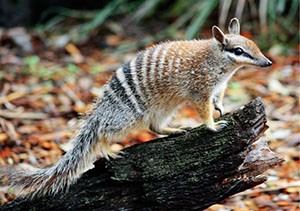
The bird emblem
The black swan
Western Australia, which was often referred to as the Swan River Colony in its early days, proclaimed the black swan its state bird emblem on 25 July 1973.
This graceful bird had a special association with Western Australia from the earliest times. Dreaming Stories tell how ancestors of the Noongar people, the Indigenous Australian peoples living in the south‑west of the state, were once black swans who became men.
In 1697, Dutch explorer Captain Willem de Vlamingh sighted flocks of black swans in the estuary and subsequently named it the Swan River. Although the black swan can be found throughout Australia, it has been regarded with special affection by many generations of Western Australians and has long been used to identify things as Western Australian.
The bird has a red beak with a white band near the top, black plumage and pure white flight feathers. The voice of the black swan is often heard at night as a musical honk or bugling sound.
The nests are a bulky collection of sticks and rushes found in swamps and lakes. Between 4 and 8 eggs are laid. The eggs are pale green, becoming paler as incubation proceeds. Swans feed on water plants and animals.
A design showing the black swan was chosen for the first Western Australian postage stamps, issued in 1854.
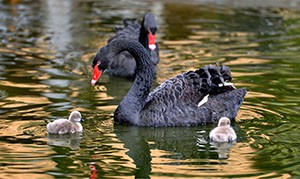
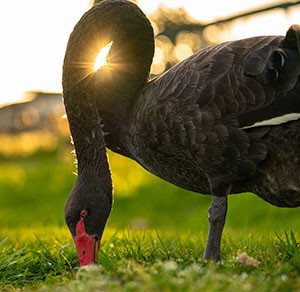
The marine animal emblem
Whale shark
The whale shark was proclaimed as Western Australia's marine animal emblem on 12 November 2013.
In the dappled light of the ocean, the whale shark can swim past almost unnoticed despite its size due to its grey skin with yellow markings that act as camouflage. This pattern is unique to each animal and much like a human fingerprint, can be used to identify them. The markings and its large mouth (up to 1.5 metres wide) distinguish the whale shark as a striking inhabitant of the ocean.
The species originated approximately 60 million years ago and represents a link to the prehistoric past. Whale sharks live for 70 to 100 years and do not reproduce until they reach approximately 9 metres in length. It takes a whale shark pup up to 30 years to reach this size.
Although they are found in tropical and warm oceans across the equator, whale sharks have become famous for their gathering during autumn and winter in oceans off Western Australia and have been seen as far south as the Kalbarri Cliffs. Whale Sharks are capable of diving to depths of 1,286 metres but usually spend their time swimming and surface feeding. This makes Western Australia one of the best places in the world to see these spectacular creatures.
Whale sharks are a vulnerable species and in Western Australia they are respected and protected.
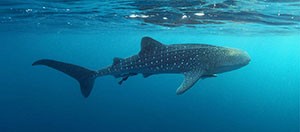
The fossil emblem
Gogo fish
The gogo fish was proclaimed as Western Australia's fossil emblem on 5 December 1995. The initiative for Western Australia to adopt a fossil emblem and for that emblem to be Mcnamaraspis kaprios came from pupils of a Perth primary school.
If you were a shrimp-sized fish 375 million years ago, swimming in the tropical reefs of prehistoric Western Australia's far north, the terror in your life would have been the sharp‑toothed gogo fish.
From the shales known as the Gogo Formation that formed in quiet inner-reef bays, have come exquisitely preserved, three-dimensional skeleton of the fishes that swam in these ancient seas. Preserved as original bone in limestone nodules within the shale, they represent the best-preserved early fishes in the world.
The gogo fish had a shark-like dorsal fin and grew to be about 25 centimetres long. It had a bony head shield which swiveled in a ball‑and‑socket joint in the fish's trunk.
The fossils show that the fish had a special cartilage in its snout indicating that these placoderms, a group of ancient armoured fish, were close relatives of sharks.
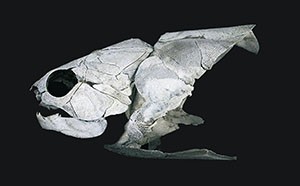
For further information on the symbols of Western Australia, please contact:
Protocol and State Events
Department of Premier and Cabinet
Locked Bag 3001
West Perth WA 6872
Phone: 08 6552 6333
Email: ProtocolBranch@dpc.wa.gov.au
